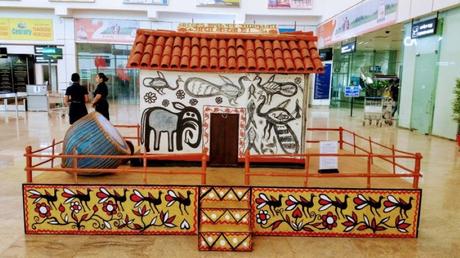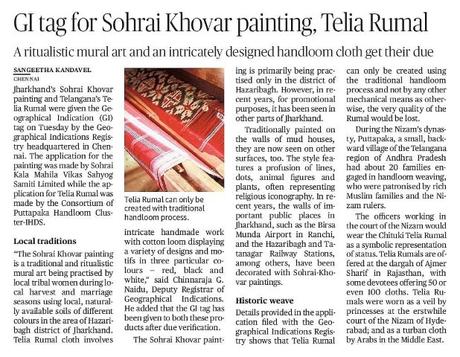
The Sohrai and Khovar painting of Jharkhand got the GI ( Geographical Indication) tag by the Geographical Indications Registry headquartered in Chennai. The application was made by the Sohrai Kala Mahila Vikas Sahyog Samiti Limited which was accepted by the registry on Tuesday, 12th May 2020.
Let's know more about the ancient paintings of Sohrai and Khovar.
Table Of Contents
What Is A Geographical Indication (GI)?
Geographical Indication is a sign used on products having a specific geographical origin i.e it originated from a specific town, region, or country.
The GI tag is a kind of certificate ensuring that the product is made according to the traditional methods used in its place of origin or possess certain qualities or has a certain reputation due to its geographical origin.
 Reference - The Hindu
Reference - The Hindu Sohrai Paintings - The State Art Of Jharkhand
Sohrai, also known as the cattle festival is a harvest festival celebrated in the states of Jharkhand, Bihar, Chhatisgarh, Odisha, and West Bengal. The festival is mainly celebrated by Prajapati, Kurmi, Santal, Munda, and Oraons tribes of the region.
Sohrai is celebrated on the day of Amavasya in the Hindu month of Karthik which is during the month of October - November.
Coinciding with the festival of Diwali, Sohrai is celebrated to welcome winter harvest and to worship the cattle and nature as a thanksgiving measure for the harvest.
Sohrai painting is the state art of Jharkhand painted during the Sohrai festival. It originated in the Hazaribagh district of Jharkhand and is one of the oldest forms of wall painting existing from 4000 to 10000 BC. The word 'Sohrai' originates from the paleolithic age word 'Soro' which means 'to drive with a stick'.
Why Is Sohrai Paintings Unique?
The tribal women decorate their mud houses with Sohrai wall paintings. It is usually drawn with the help of sticks, cloth swabs, fingertips, and broken combs and depicts Pashupati (the creator of animals), flowers, elephants, peacocks, sparrows, squirrels, cows, etc.
The colors used in the paintings are extracted from flowers, leaves, plants, rice, etc, and mixed with Kali Matti (Maganese black), Duddhi Matti/ Charak Matti (white mud), Lal Matti/Geru (red oxide) and Pila Matti (yellow ochre).
Sohrai painting is a matriarchal tradition that is passed on by the mother-in-law to their daughter-in-law. Earlier it was painted in caves which later got shifted to house walls.
A specific procedure is followed while painting which makes this art unique. The wall is coated with white mud and while it remains wet the painting is made.
At first red lines are drawn which symbolizes the blood of the ancestors, procreation, and fertility. Then the black lines are drawn which signifies Lord Shiva. The outer lines are drawn next representing protection, fidelity, and chastity. At last, the white lines are drawn with a mixture of previous years harvested rice and milk which represents food.
Tribal Women Artists Cooperative (TWAC), India, was formed to empower poorer women artists, promote environmental issues and highlight Khovar/Sohrai art, a tradition dating back to 10,000-4,000 B.C. and continued as paintings on the walls of the huts, where people live #womensart pic.twitter.com/AJ8jXFNX4z
- #WOMENSART (@womensart1) November 14, 2019
Khovar - The Marriage Paintings
Khovar is another age-old heritage painting originated in the Hazaribagh district of Jharkhand. The word 'Khovar' is derived from the word 'Koh' which means 'cave' and 'Var' which means 'husband'. The painting is made to decorate the marriage room of the bride and the groom and therefore, is mostly painted during the marriage season that starts from the month of January and bypasses the summer months to end at the onset of monsoon.
According to the tribal tradition, the groom pays the bride's price on the day of the marriage and spent the night in the bride's house. To decorate the marriage room of the bride-groom, the mother and aunts of the bride paint the walls with Khovar paintings.
Why Is Khovar Paintings Unique?
Khovar is also a matriarchal tradition that is passed on by the mother to their daughters. Similar to the Sohrai paintings, Khovar is also painted with natural colors extracted from flowers, leaves, plants, rice, etc, which is then mixed with Kali Matti (Maganese black), Duddhi Matti/ Charak Matti (white mud), Lal Matti/Geru (red oxide) and Pila Matti (yellow ochre).
The house wall is coated with white mud first which symbolizes the 'sperm of the father'. Before the coating dries, the painting is made using the black color which symbolizes 'the darkness of the mother's womb'.
The women make the paintings by scrapping with fingers or broken combs or by using sticks and cloth swab. The art depicts the animals and birds found in the region and their relationship counterparts.
Who Discovered The Sohrai And Khovar Paintings?
Bulu Imam, an environmental activist and a member of the Indian National Trust for Art and Cultural Heritage (INTACH) discovered the traditional Sohrai and Khovar painting. He is working since 1987 for the protection of tribal culture and heritage in Jharkhand.
He has received the Gandhi International Peach Award in the year 2011 at House of Lords in London, Padma Shri in the year 2019, and many other awards for his exceptional work.
In the year 1991, he discovered the rock art of Jharkhand at Isco (or Isko) and also many rock art sites in the Northern Karanpura Valley. In 1993, he discovered the Khovar and the Sohrai paintings on the walls of the tribal mud houses in villages of Hazaribagh. Later, he drafted the connection between the rock arts and the wall paintings found in Jharkhand.
Hazaribagh has 10 painted villages within a radius of 50 km which belongs to the different tribal communities and therefore, each of them has a unique style of painting.
The Journey From Walls To Canvas
Khovar and Sohrai paintings were almost on the verge to become extinct as the mud walls of the tribal houses were being converted into brick walls with plastered cement. Also, the tribes were migrating to the cities for work and the young girls were going to school which made them reluctant to continue the tradition.
However, many NGOs, Trusts, famous Artisians, and the Government played a huge role in promoting the paintings to the world. After people came to know about such fine art and showed their interest in acquiring them, the tribal community started painting them on handmade papers and canvasses.
Sohrai Painting For Home Decor - Curated By Team Tripinfi
From Where To Buy The Sohrai and Khovar Paintings?
The best places to buy the paintings are from the Emporiums of Jharkhand Silk Textile and Handicraft Development Corporation, also known as Jharcraft.
It is an undertaking of the Government of Jharkhand and was established to promote Sericulture, Handloom, Handicraft, and other activities to help the tribal people with their livelihood. Here are the address and contact details of Jharcraft stores located in India.
Ranchi
- Jharcraft Megastore, Annapurna Building, Main Road Ranchi, Near Overbridge. RANCHI -834001. Contact: +91-9771458151.
- Jharcraft Emporium, Birsa Munda Airport, Airport Road, Khokambatoli, Hinoo RANCHI -834002. Contact: +91-8294534471.
Dumka
- Jharcraft Emporium, Near Siddhu Kanhu High School, Thana Road, Dumka. 814101 JHARKHAND. Contact: +91-9470101114.
Dhanbad
- Jharcraft Emporium, Unit No.- 202, Ozone Galleria Saraidhela, Dhanbad - 826001. Contact: +91-7781018284.
Hazaribagh
- Jharcraft Emporium, Urban Haat, Homeguard Training Center, Hazaribagh. Contact: +91-9334682296, +91-8651426433.
New Delhi
- Jharcraft Emporium, Shop No. 141, Bikaji Cama Place, August Kranti Bhawan. Contact: +91-9560963008.
Bangalore
- Jharcraft Emporium, 47 St. John Road, Near Commercial Street, BANGALORE - 560042. Contact: +91-9916713667, 08025306881.
Kolkata
- Jharcraft Emporium, 3D, Camac Street, KOLKATA-16. Contact: +91-8017541920.
- Jharcraft Emporium, Mullick's Service Centre, Hindustan Petroleum Corporation LTD. Narendrapur, KOLKATA - 103. Contact: +91-9831160734.
- Jharcraft Emporium, Hindustan Petroleum Corporation LTD., Debi Service Station 362, SNC BOSS Road Naktala, KOLKATA. Contact: +91-9831160734.
Lapung
- Jharcraft Rural Mart, Lapung, Shirdi Sai Gram Vikash Kendra, Sarsa, P.O. - Deogaon, Block - Lapung.
Kharsawa
- Jharcraft Rural Mart, Kharsawa, Agra Pariyojna Kendra, KHARSAWA.
Can We Buy The Paintings Online?
The paintings can be bought online. Here is a list of shopping sites

